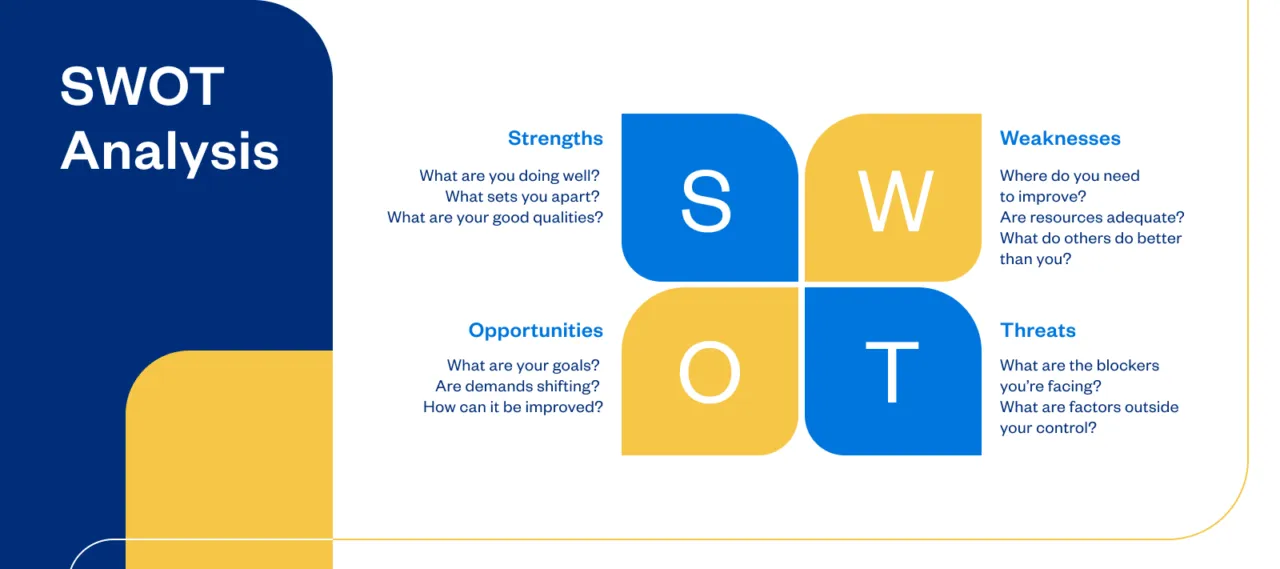SWOT Analysis: What It Is & How to Do It

Would you like a more rounded picture of your marketing strategy before you make hefty decisions? Do your strategy meetings sometimes lack structure or always follow the same format with the same results?
Doing your own SWOT analysis will help scaffold your thinking and create a more effective marketing strategy.
SWOT analysis has considerable heritage – it’s been used by businesses and other organizations since the 1960s as a successful strategic planning technique. It’s a simple structure that brings together all the internal and external factors that impact your next business decision.
A SWOT analysis, marketing-wise, gives you a 360 view of your next project, campaign, or strategy. It means you can test your objective against your strengths and weaknesses before implementation. Once you’ve done your marketing SWOT analysis, you can lean into those positive attributes and mitigate the risks you’ve identified.
For marketing managers, this gives you confidence in your decisions and puts good reasoning behind all your marketing efforts.
Here’s what we’ll cover:
- What Is a SWOT Analysis?
- Why Use the SWOT Analysis for Marketing Strategy?
- How to Do a SWOT Analysis
- SWOT Analysis in Action
- Downsides of SWOT Analysis
- Key Takeaways

What Is a SWOT Analysis?
Let’s start with the name. SWOT is an acronym, which stands for:
- Strengths
- Weaknesses
- Opportunities
- Threats
A SWOT analysis uses a grid framework that’s divided into quadrants, one for each of the headings. This SWOT analysis template isn’t exclusively for marketing decisions. It’s used across businesses and other organizations during all kinds of decision-making scenarios. But it’s not just for multi-department, large corporations. Small businesses are equally able to use SWOT analyses to their benefit.
Doing a SWOT analysis covers the internal and external factors that impact the success of your marketing (or other business) objective.
- Internal factors: The strengths and weaknesses that are under your control within your business.
- External factors: The opportunities and threats that are outside your control, but still impact your business.
By looking at your strengths, weaknesses, opportunities, and threats together, you have a clear idea of your existing potential, opportunities for the future, and threats you can now mitigate.

Why Use the SWOT Analysis for Marketing Strategy?
Now you’re clear on what a SWOT analysis is, why would you use it in a marketing context?
There are so many ways your thinking can be deepened by using a SWOT analysis, to figure out how to make your current marketing strategy even more successful. For example, a SWOT analysis helps answer questions like:
- What’s our best (and worst) performing product/service?
- What new trends are we not taking advantage of?
- Is there a new target market for a classic product/service?
- How do our marketing tactics compare to our competitors?
- Why do we have customer churn with X service/product?
- Is it worth having a stand at that Trade Show?
- How do we increase brand awareness with X demographic?
- How do we get more subscribers to our free trial?
- Where do we start?
That’s just some of the things you’ll be thinking about in terms of your own marketing strategy. What’s your latest product line campaign, project or problem? Get your team together, do a SWOT analysis, and get a clear path forward.
How to Do a SWOT Analysis
Now you’ve decided to support your strategic planning with a SWOT analysis, you need to know how you actually do it—especially if you’re leading. First things first: Any good meeting comes with good snacks. You know your office favorites!
Now you need to follow our step-by-step guide on how to do a marketing SWOT analysis:
1. Set Up Your SWOT Matrix
Decide how you’re going to present your SWOT matrix. Maybe using a downloaded SWOT analysis template to share on your IWB. Or go old school with an actual whiteboard and pen. Label each of the 4 quadrants; Strengths, Weaknesses, Opportunities, and Threats. Physically, you’re ready to start.
2. Establish Your Focus
All SWOT analyses need a clear focus, which you must determine at the beginning of the process. Really focus on what exactly you want to achieve. The more specific, the better.
Decide on a timetable and how you’re going to measure the success of your objective over this time period. Once you’ve clearly identified your destination, you can plan your route using your SWOT analysis.
3. Gather Data
Like all good marketers, you understand the importance of research. This is where you gather all the data you can about the internal and external factors that are relevant to your marketing swot analysis objective.
If you’re introducing your marketing team to the SWOT framework for the first time, it’s also a good idea to give a SWOT analysis definition to each of the 4 sections.
Strengths
You’ll know the answer to most of these questions very well. But it’s good to collect them together to see what you should be doing more of. This involves getting specific about your company’s unique selling proposition (USP) and how this gives you an advantage over your competition—as it relates to your SWOT analysis objective.
Consider factors like robust social media presence, strong brand identity, and recognition, staff technical expertise, actively engaged audience, vocal brand advocates, and precise market research.
Weaknesses
Here you’re looking for internal factors that are limiting your ability to reach your goal. Consider things like financial resources, perception of audience, what takes time away from your staff unnecessarily, and lack of technology.
It can be much harder for businesses to really get a bird’s eye view on their own weaknesses, because you’re so entrenched ‘in’ the business. But your SWOT analysis isn’t complete, or as useful, without these trickier internal factors.
Opportunities
These are external factors that will have a positive outcome for you. What haven’t you tried yet? What isn’t already in your marketing plan? Are there industry trends that you can benefit from? Is there an untapped source of funding somewhere? What emerging markets are good for you?
There are so many external opportunities that this could be a slightly overwhelming part of the SWOT analysis process. But try and keep your focus on opportunities that directly relate to the objective under scrutiny.
Threats
There are external factors that prevent you from reaching your objective. Things that are out of your control and a risk to your business. That might include losing loyal customers, decreasing market share because of new technologies, rising cost of raw materials, and over-reliance on a single channel for generating new leads.
Sometimes, if you’re struggling to identify these kinds of external threats, it might be a good idea to schedule a separate PESTEL analysis before you go any further.
4. Evaluate Results
Your SWOT analysis gives you information. Hopefully, you’ve managed to narrow it down to information that’s relevant to your defined objective. But right now, its probably a combination of old and new information that covers all the strengths, weaknesses, opportunities, and threats that impact on your objective.
It’s what you do now that’s important. How are you going to apply your strengths to realize the best opportunities? Can you turn your weaknesses into strengths, or otherwise minimize their effect on your outcomes? And how are you going to mitigate the threat posed by those external risks?
A good marketing SWOT analysis gives you excellent data to work from. You need to use your analysis to plan your marketing strategy.
SWOT Analysis in Action
Maria is the marketing manager for a company called Minerva, which specializes in wearable tech to support women’s health. She wanted to know why customers were leaving low ratings online and whether her company should target new markets with its next campaign.
She led a SWOT analysis with a team comprised of people from different departments across the company.
As an additional benefit, she really wanted her marketing team to hear the company’s strengths, as they had been demoralized by dealing with the fallout of the poor ratings and comments being left by customers.
After much discussion, their SWOT analysis looks like this:
Strengths
- Powerful engineering
- Good sales network
- Quality products
- Strong R&D
Weaknesses
- Slow response to customer requests
- Sluggish response to market trends
- High manufacturing cost
- Long delivery time
Opportunities
- Regulations and restrictions are being relaxed
- Customized products required by the market
- Required R&D projects
- The market is growing
Threats
- Vulnerable to the influence of overseas competitors
- New technology makes products obsolete
- The competition has fresher ideas
- Increased competition
Results
The SWOT analysis highlights the strengths, weaknesses, opportunities, and threats in Minerva’s different departments. But how does it help Maria to answer the questions she had at the outset?
- Why are customers leaving so many low ratings and negative reviews?
It’s clear that the long delivery times and slow customer service responses are internal factors that need to be remedied quickly. They are causing reputation damage and discouraging repeat customers. Eliminating these weak points should be a high priority for the company.
- What new markets can be the targets of the next marketing campaigns?
There are exciting opportunities for this growing market. It’s clear to Maria that their next campaign should target countries that are relaxing their regulations the quickest. As well as pushing their new customized products to their existing customers.
Other unexpected things to come out of the SWOT analysis:
- The strong engineering team can counter the threats in the market where competitive technology might make Minerva’s products obsolete.
- To grow its market share and ensure cash flow, Minerva must resolve the shipping time issues immediately.
- Threats from emerging competition can be minimized by applying taking advantage of industry growth, bringing new technologies and products to market, and advertising in new, deregulated countries. The strengths of the team mitigate the worst threats.
From this one SWOT analysis, Minerva learned some useful things about their current customer relationships and their vast potential opportunities, which they can turn into actionable strategies.
Maria now understands where the negative public feedback comes from and where to start researching for her next launch campaign. She’s already decided to get their most vocal brand advocates on the job. And it gives Maria a lot of leverage at the next budget meeting when she’s asking for a substantial increase for the marketing department.

Downsides of SWOT Analysis
A good SWOT analysis collects relevant data together in one place. You get your strengths, weaknesses, opportunities, and threats all there in front of you. And you curate them until everything on your SWOT matrix relates to the objective in question.
But a SWOT analysis is not a:
- List of actions
- Strategy
- Selection of prioritized solutions
- Focused conclusion
A marketing SWOT analysis is a great structure to think and talk in, but it isn’t a solution in itself. That’s in the marketing strategy you create with your SWOT data.
Key Takeaways
The SWOT analysis is a tried and tested tool to help you make the most of your marketing strategy, resources, and budget.
Businesses often find the SWOT process itself to be useful, especially if there’s a company-wide objective or decision to be made. Just giving people in different roles, with different perspectives, the time to listen to each other is hugely beneficial. Focusing on an objective keeps conversations on track and away from any fault finding—especially when it comes to internal weaknesses.
Using SWOT as a tool to fine-tune your marketing strategy gives you confidence that you’ve really got a 360 view of your next steps to success.
RELATED ARTICLES

 What Is Market Growth Rate & How to Calculate It?
What Is Market Growth Rate & How to Calculate It? How to Market a Product: 5 Effective Ways
How to Market a Product: 5 Effective Ways What Is Local SEO? A Simple How-To Guide for Small Businesses
What Is Local SEO? A Simple How-To Guide for Small Businesses 8 Marketing Strategies for Small Businesses
8 Marketing Strategies for Small Businesses 10 Ways to Promote Your Business Online
10 Ways to Promote Your Business Online How to Create a Marketing Plan?
How to Create a Marketing Plan?